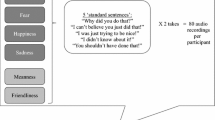Abstract
This research aimed to assess individual’s abilities in decoding emotional vocal expressions according to attachment styles and Narrative Identities. To this aims 30 students (15 females, 15 males; mean age = 21.4 ± 2.47) were recruited at the Second University of Naples (Italy) and underwent an emotional-voice-decoding task after being tested through the “Experience in Close Relationships” (ECR) and Personality Meaning (PMQ) Questionnaire to assess their attachment styles and Narrative Identities. The results showed that Outward subjects were more accurate in decoding joy and surprise especially in the group of individuals with an Insecure attachment style, suggesting that emotional regulation dynamics and attachment parameters shape the ways individuals develop their ability to decode other emotional feelings.
The names of the authors are in alphabetic order since each made a significant contribution to the research reported.
Access this chapter
Tax calculation will be finalised at checkout
Purchases are for personal use only
Preview
Unable to display preview. Download preview PDF.
Similar content being viewed by others
References
Izard, C.E.: Innate and Universal Facial Expressions: Evidence from Developmental and Cross-Cultural Research. Psychol. Bull. 115, 288–299 (1994)
Harris, P.L.: Individual Differences in Understanding Emotion: The Role of Attachment Status and Psychological Discourse. Attach. Hum. Dev. 1, 307–324 (1999)
Laible, J.D., Thompson, R.A.: Attachment and Emotional Understanding in Preschool Children. Dev. Psychol. 34, 1038–1045 (1998)
Suslow, T., Dannlowski, U., Arolt, V., Ohrmann, P.: Adult Attachment Avoidance and Automatic Affective Response to Sad Facial Expressions. Aust. J. Psychol. 62, 181–187 (2010)
De Rosnay, M., Harris, P.L.: Individual Differences in Children’s Understanding of Emotion: The Roles of Attachment and Language. Attach. Hum. Dev. 4, 39–54 (2002)
Colle, L., Del Giudice, M.: Patterns of Attachment and Emotional Competence in Middle Childhood. Soc. Dev. 20, 51–69 (2011)
Steele, H., Steele, M., Croft, C.: Early Attachment Predicts Emotion Recognition at 6 and 11 Years Old. Attach. Hum. Dev. 10, 379–393 (2008)
Arciero, G.: Sulle Tracce di Sé. Bollati Boringhieri, Torino (2006)
Arciero, G., Bondolfi, G.: Selfhood, Identity and Personality Styles. Wiley BlackWell, Hoboken (2011)
Guidano, V.F.: Le Dimensioni del Sé. Una lezione sugli sviluppi del modello post-razionalista. Alpes Italia, Roma (2010)
Nardi, B.: CostruirSi. Sviluppo e Adattamento del Sé nella Normalità e nella Patologia. Franco Angeli, Milano (2007)
Arciero, G., Gaetano, P., Maselli, P., Gentili, N.: Identity, Personality and Emotional Regulations. In: Freeman, A., Mahoney, M.J., Devito, P. (eds.) Cognition and Psychotherapy, 2nd edn., ch. 12, pp. 261–269. Springer, Heidelberg (2004)
Gross, J.J.: Emotion Regulation in Adulthood: Timing is Everything. Curr. Dir. Psychol. Sci. 10, 214–219 (2001)
Arciero, G., Gaetano, P., Maselli, P., Mazzola, V.: Le Organizzazioni di Significato Personale. In: Bara, B. (ed.) Nuovo Manuale di Psicoterapia Cognitiva, vol. 1, pp. 17–38. Bollati Bolinghieri, Torino (2005)
Russell, J., Bachorowski, J.A., Fernandez-Dols, J.M.: Facial and Vocal Expressions of Emotions. Annu. Rev. Psychol. 54, 329–349 (2002)
Brennan, K.A., Clark, C.L., Shaver, P.R.: Self Report Measurement of Adult Attachment: An Integrative Overview. In: Simpson, J.A., Rholes, W.S. (eds.) Attachment Theory and Close Relationships, pp. 46–76. Guilford Press, New York (1998)
Picardi, A., Vermigli, P., Toni, A., D’Amico, R., Bitetti, D., Pasquini, P.: Evidence of the Validity of the Italian Version of the Questionnaire “Experiences in Close Relationships” (ECR), a Self-Report Instrument to Assess Adult Attachment. Ital. J. Psychopathol. 8, 282–294 (2002)
Picardi, A., Bitetti, D., Puddu, P., Pasquini, P.: La scala Experiences in Close Relationships (ECL), un Nuovo Strumento per la Valutazione dell’Attaccamento negli Adulti: Traduzione, Adattamento, e Validazione della Versione Italiana. Riv. Psichiatr. 3, 114–120 (2000)
Picardi, A.: First Steps in the Assessment of Cognitive-Emotional Organization within the Framework of Guidano’s Model of the Self. Psychother. Psychosom. 72, 363–365 (2003)
Ekman, P., Friesen, W.V., Hager, J.C.: The Facial Action Coding System, 2nd edn. Weidenfeld & Nicolson, Salt Lake City (2002)
Esposito, A.: The Perceptual and Cognitive Role of Visual and Auditory Channels in Conveying Emotional Information. Cogn. Comp. 1, 268–278 (2009)
Esposito, A., Riviello, M.T.: The New Italian Audio and Video Emotional Database. In: Esposito, A., Campbell, N., Vogel, C., Hussain, A., Nijholt, A. (eds.) COST 2102. LNCS, vol. 5967, pp. 406–422. Springer, Heidelberg (2010)
Author information
Authors and Affiliations
Corresponding author
Editor information
Editors and Affiliations
Rights and permissions
Copyright information
© 2015 Springer International Publishing Switzerland
About this chapter
Cite this chapter
Esposito, A., Palumbo, D., Troncone, A. (2015). Effects of Narrative Identities and Attachment Style on the Individual’s Ability to Categorize Emotional Voices. In: Bassis, S., Esposito, A., Morabito, F. (eds) Advances in Neural Networks: Computational and Theoretical Issues. Smart Innovation, Systems and Technologies, vol 37. Springer, Cham. https://doi.org/10.1007/978-3-319-18164-6_25
Download citation
DOI: https://doi.org/10.1007/978-3-319-18164-6_25
Publisher Name: Springer, Cham
Print ISBN: 978-3-319-18163-9
Online ISBN: 978-3-319-18164-6
eBook Packages: EngineeringEngineering (R0)




